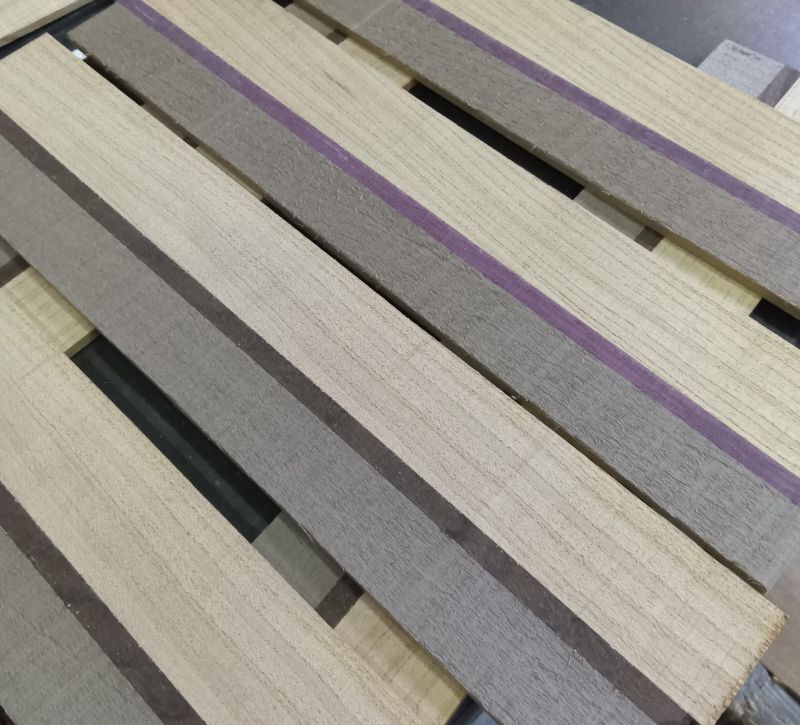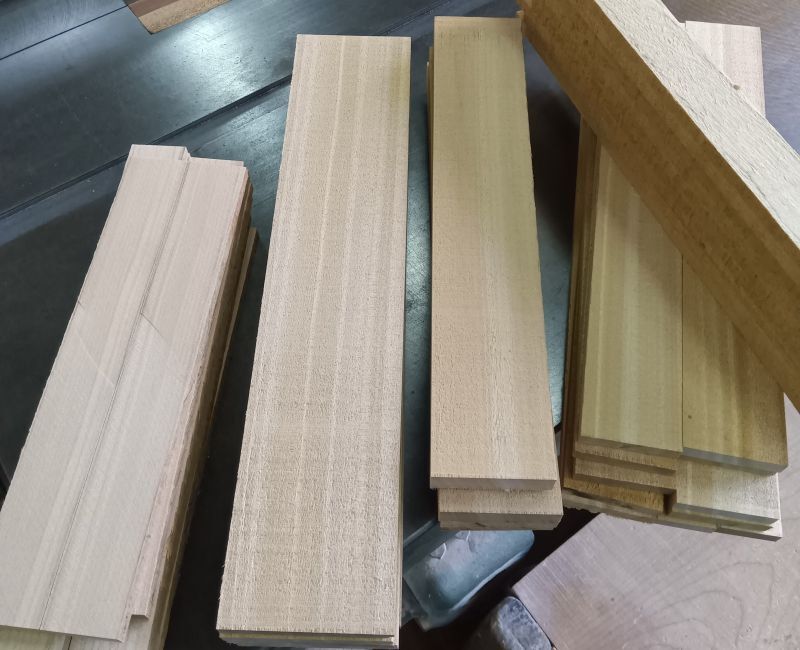Double panel
I'm currently working on the top and bottom panels for the 4-sun double compartment Himitsu-bako I mentioned the other day. This time, two-thirds of this puzzle box will feature Traditional yosegi (top/bottom panels), while the remaining qry. will be made of natural wood for the top and bottom panels. The attached photo shows the panels I’m using. The arrangement of the wood differs slightly between the top and bottom panels. One panel consists of three types of wood: keyaki, Purpleheart, and hoo (magnolia), while the other panel uses keyaki, jindai katsura, and hoo. Since the inside of the box is divided into two compartments, I thought it would be more interesting to vary the wood types slightly between the top and bottom panels rather than using the same material for both.
This time, I’m using jindai katsura on one of the panels for the first time in a while. This wood is very rare and hard to come by. For a craftsman like me, who uses small quantities, it's not an issue, but for others who require large amounts, like Yosegi craftsmans, sourcing this wood can be quite challenging. Nowadays, in many cases, black substitute woods are used instead.
As I mentioned in a previous blog post, this wood (Jindai Katsura) is sourced from trees that were buried underground and then excavated just before turning into charcoal. This discovery is not intentional; the wood is found by chance. That’s why it has a black color (as charcoal). If it were to turn into charcoal and remain underground, it would eventually decay. Therefore, the wood in this excavated state is softer than the original katsura wood. When used alongside the other two types of wood in the photo, it is softer and can sometimes become indented compared to the neighboring woods. Because of this, it is important to carefully process the wood during sanding and finishing so that all three types of wood are leveled to the same height.
Wood hardness varies significantly depending on the species. Among the woods being used in this project, keyaki and Purpleheart woods are as hard as stone, while hoo wood is very soft.
Today, I started preparing the materials for a 6-sun, 54-step Himitsu-bako. I plan to make them between this week and next week. This time, I’m making six (is that too few?😅). I’m planning to create three of them in a natural wood style for sale here. The photo shows "the structural materials" for 6pcs. 6-sun 54-step Himitsubako.
This time, I’m using jindai katsura on one of the panels for the first time in a while. This wood is very rare and hard to come by. For a craftsman like me, who uses small quantities, it's not an issue, but for others who require large amounts, like Yosegi craftsmans, sourcing this wood can be quite challenging. Nowadays, in many cases, black substitute woods are used instead.
As I mentioned in a previous blog post, this wood (Jindai Katsura) is sourced from trees that were buried underground and then excavated just before turning into charcoal. This discovery is not intentional; the wood is found by chance. That’s why it has a black color (as charcoal). If it were to turn into charcoal and remain underground, it would eventually decay. Therefore, the wood in this excavated state is softer than the original katsura wood. When used alongside the other two types of wood in the photo, it is softer and can sometimes become indented compared to the neighboring woods. Because of this, it is important to carefully process the wood during sanding and finishing so that all three types of wood are leveled to the same height.
Wood hardness varies significantly depending on the species. Among the woods being used in this project, keyaki and Purpleheart woods are as hard as stone, while hoo wood is very soft.
Today, I started preparing the materials for a 6-sun, 54-step Himitsu-bako. I plan to make them between this week and next week. This time, I’m making six (is that too few?😅). I’m planning to create three of them in a natural wood style for sale here. The photo shows "the structural materials" for 6pcs. 6-sun 54-step Himitsubako.

